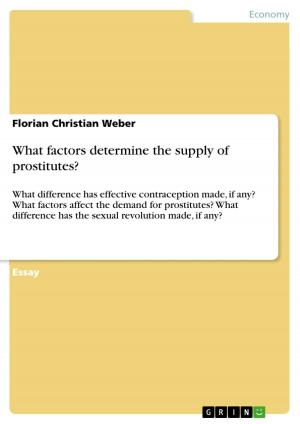| Author: | Patrick Spieß | ISBN: | 9783640883165 |
| Publisher: | GRIN Publishing | Publication: | April 4, 2011 |
| Imprint: | GRIN Publishing | Language: | English |
| Author: | Patrick Spieß |
| ISBN: | 9783640883165 |
| Publisher: | GRIN Publishing |
| Publication: | April 4, 2011 |
| Imprint: | GRIN Publishing |
| Language: | English |
Seminar paper from the year 2010 in the subject English Language and Literature Studies - Literature, grade: 2,3, Martin Luther University, language: English, abstract: This seminar paper deals with the graphic novel 'Maus' by Art Spiegelman. The book was published in two volumes. The first volume with the subtitle: 'My Father Bleeds History'(1986) and the second volume had the subtitle: 'And Here My Troubles Began' (1991). The novel is about the genocide of European Jews. The action is centered on the Holocaust survivor Vladek Spiegelman, who was imprisoned in Auschwitz. His son Art Spiegelman reconstructs the story of his father by interviewing him and taking notes. During the novel the author Art Spiegelman informs the reader also about his mother Anja and himself. First of all, there is the question of how to deal with the medium comic, because comics represent actually funny stories but the Holocaust is anything but funny thus they are extreme opposites. However, Spiegelman started a new era of comics, because he showed which opportunities exist in this medium and introduced the genre to a mass audience. He was able to do this, because he does not want to tell the complete history of the Holocaust but only a story of a survivor. The book includes three different time levels. The first one is the tale of woe of his father, who survives the Holocaust, the second one is where Art interviews his father about his experiences and memories and the third time level acts after Vladek's death and shows Art working on the second volume of 'Maus'. Due to the jumping between the time levels emerges close connection between present and past, thereby the story appears truer. The exact title of this seminar paper is Characterization and symbolism in 'Maus' and will deal with the question of what happens with stereotypes of nationalism and how Spiegelman reflect personalities. First, the genre of the book will be examined by characteristics of fables and allegories. Furthermore, the question will be why Spiegelman decided to choose animal figures and how he characterized them and which advantages the choice of animals in correspondence with the medium comic has. The characterization and symbolism will be mostly checked on the basis of the primary literature. Critical voices will be obtained by secondary literature. Moreover, this seminar paper will amplify several symbols and metaphors and ultimately, the last chapter will try to read out a moral and a massage. Questions whether 'Maus' is a biography or an autobiography, yiddishkeit and parenthood will be left out, because it would go beyond the scope of this paper.
Seminar paper from the year 2010 in the subject English Language and Literature Studies - Literature, grade: 2,3, Martin Luther University, language: English, abstract: This seminar paper deals with the graphic novel 'Maus' by Art Spiegelman. The book was published in two volumes. The first volume with the subtitle: 'My Father Bleeds History'(1986) and the second volume had the subtitle: 'And Here My Troubles Began' (1991). The novel is about the genocide of European Jews. The action is centered on the Holocaust survivor Vladek Spiegelman, who was imprisoned in Auschwitz. His son Art Spiegelman reconstructs the story of his father by interviewing him and taking notes. During the novel the author Art Spiegelman informs the reader also about his mother Anja and himself. First of all, there is the question of how to deal with the medium comic, because comics represent actually funny stories but the Holocaust is anything but funny thus they are extreme opposites. However, Spiegelman started a new era of comics, because he showed which opportunities exist in this medium and introduced the genre to a mass audience. He was able to do this, because he does not want to tell the complete history of the Holocaust but only a story of a survivor. The book includes three different time levels. The first one is the tale of woe of his father, who survives the Holocaust, the second one is where Art interviews his father about his experiences and memories and the third time level acts after Vladek's death and shows Art working on the second volume of 'Maus'. Due to the jumping between the time levels emerges close connection between present and past, thereby the story appears truer. The exact title of this seminar paper is Characterization and symbolism in 'Maus' and will deal with the question of what happens with stereotypes of nationalism and how Spiegelman reflect personalities. First, the genre of the book will be examined by characteristics of fables and allegories. Furthermore, the question will be why Spiegelman decided to choose animal figures and how he characterized them and which advantages the choice of animals in correspondence with the medium comic has. The characterization and symbolism will be mostly checked on the basis of the primary literature. Critical voices will be obtained by secondary literature. Moreover, this seminar paper will amplify several symbols and metaphors and ultimately, the last chapter will try to read out a moral and a massage. Questions whether 'Maus' is a biography or an autobiography, yiddishkeit and parenthood will be left out, because it would go beyond the scope of this paper.















